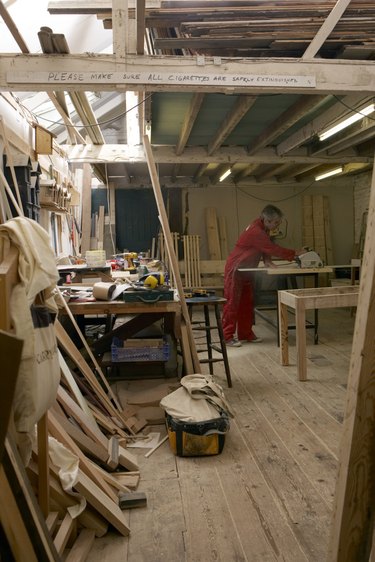
Every tool has its limitations. A handsaw can help you craft furniture for your house, but it won't chop down a tree. A chainsaw can get that tree down but won't help you with making furniture. Planers -- woodworking tools found commonly in professional shops and tool kits -- serve a very specific purpose. Understanding whether you can cut angles with a planer requires an understanding of exactly what planers do and how you use them.
Planers
Video of the Day
Planers are power tools used to finish the surface of wood. You can purchase handheld planers for maneuverability and small jobs, or you can use a large floor unit for finishing large quantities of wood. Planers use a system of knives to shave material from the surface of wooden beams and boards to create a flat, even finish. Professionals use planers to transform raw lumber into good building material. You can also use planers to create even surfaces on wood in your home that has warped or changed over years of use.
Video of the Day
Cutting Angles
The simple answer as to whether you can cut angles with a planer is, no. The reason for this lies in how a planer operates. Though they contain blades, or knives, planers work to shave wood, not cut it. A planer uses its blades to shave the surface off of a piece of wood to a uniform depth to create a flat, smooth finish. Technically speaking, you can't use a planer to cut angles because planers don't cut.
Shaving Angles
Planers won't cut angles, but you can use them to shave angles into a piece of wood. A planer works to create a uniform finish on any surface to which you apply it. If you apply a planer to the corner of a piece of wood, it shaves that corner down until it creates a uniform surface at an angle with the faces of the piece of wood. In this way, you can create angles with planers, though this action does not technically qualify as cutting.
Using a Planer for Angles
Always exercise caution when using a planer for shaving angles. Place the wood to be shaved at an angle on a flat surface by supporting it with other pieces of wood with angled surfaces -- this creates a V-shaped notch to support your material. Always wear gloves and safety glasses when working with a planer or other wood or metal shaving or shaping tool. For optimal performance and safety when shaving angles, use a V-groove notch attachment for your planer, designed specifically for this purpose.